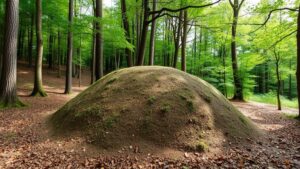Unearthing Stone Pendants and Adornments in Tribal Habitation Zones
Unearthing Stone Pendants and Adornments in Tribal Habitation Zones
The discovery of stone pendants and adornments in tribal habitation zones offers a fascinating glimpse into the spirituality, artistry, and daily lives of ancient cultures. These artifacts are not only decorative but serve myriad functions, from status symbols to ritualistic items. This article delves into the significance, methods of unearthing, and analysis of these stone artifacts within their cultural contexts.
The Cultural Significance of Stone Pendants
Stone pendants, often inscribed with intricate designs or shaped into specific forms, hold great cultural importance for tribes worldwide. For example, among the indigenous peoples of North America, pendants carved from materials like bones and stones often signify spiritual beliefs or tribal affiliations. Archaeological finds in areas such as the Great Lakes region reveal that these items served as totems of identity, connecting individuals to their ancestors and communal narratives.
Also, findings indicate that these pendants were not simply personal adornments; they symbolized membership and status within tribes. A study conducted by the American Antiquity journal noted that certain shapes of pendants were exclusive to elite members of specific tribes, highlighting the intertwined nature of art, power, and identity.
Methods of Unearthing Stone Artifacts
The process of unearthing stone pendants in tribal habitation zones often involves methodologies rooted in archaeological practices. Key techniques include:
- Site Surveys: Initial assessments involve walking through the area to locate surface artifacts, providing essential data on potential dig sites.
- Excavation: Systematic digging in layers allows archaeologists to establish chronological contexts for discoveries.
- Stratigraphy: This technique helps in understanding the layered deposits at a site, revealing how different cultures may have utilized similar spaces over time.
For example, extensive excavations at the Cahokia Mounds in Illinois have unearthed numerous stone pendants, enabling researchers to correlate them with the socio-political dynamics of the Mississippian culture.
Analytical Techniques and Case Studies
Following excavation, various analytical techniques help in examining the artifacts. Methods such as radiocarbon dating and materials analysis using tools like X-ray fluorescence (XRF) are crucial. A case study on the stone pendants found in the Andes shows that using XRF helped determine the geological sources of the materials, revealing trade networks among ancient tribes.
Also, stylistic analyses reveal personal artistry and the evolution of design over time, reflecting cultural changes. For example, pendants found in the archaeological site of Çatalhöyük in Turkey exhibit evolving motifs that indicate shifts in religious beliefs and social structures over several millennia.
Real-World Applications of Findings
The discoveries of stone pendants extend beyond academic knowledge, impacting contemporary society in various ways. For example, these findings can:
- Enhance Cultural Preservation: Understanding historical artifacts assists modern tribes in maintaining cultural heritage.
- Inform Artisanship: Insights into traditional techniques can inspire present-day artists, promoting a revival of indigenous craftsmanship.
- Support Education: Archaeological findings can be utilized in educational curricula to teach students about their ancestral roots and the importance of heritage.
Conclusion and Actionable Takeaways
The unearthing of stone pendants and adornments in tribal habitation zones reveals valuable insights into ancient cultures beliefs and practices. By employing systematic excavation and advanced analytical methods, researchers continue to illuminate the intricate dynamics at play within these societies. As we advance into the future, it is vital to support both archaeological endeavors and the communities that rely on these artifacts for their heritage.
For individuals interested in getting involved, consider the following:
- Participate in local archaeology projects or volunteer programs.
- Support museums and cultural institutions that preserve indigenous heritage.
- Educate others about the significance of these artifacts in contemporary discussions surrounding cultural identity and preservation.
